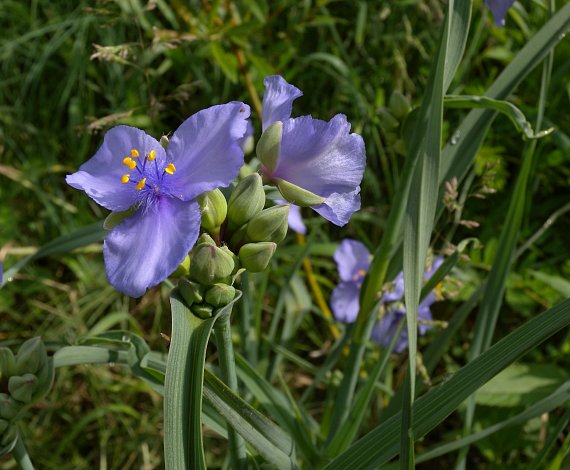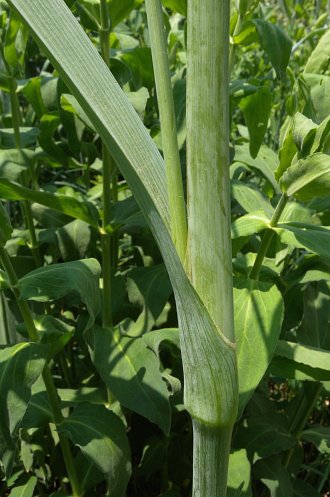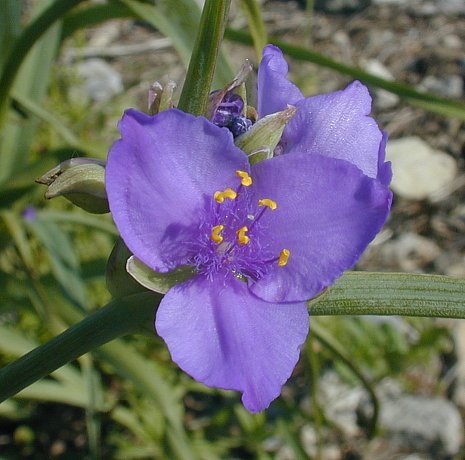Description: This is a herbaceous perennial plant about 2-4' tall and mostly unbranched, except toward the apex. The central stem is round, glabrous, and occasionally glaucous. The grey- or blue-green alternate leaves are up to 15" long and 1" across. They are linear, although wider at the base, where the leaves wrap around the stem in sheaths, than at the tip. They are also glabrous, with parallel venation and smooth margins, tending to bend downward towards the middle. The light violet to blue-violet flowers occur in small clusters on hairless flowering stems at the top of the plant. Underneath each inflorescence are 2 small bracts, each up to 3" long and less than ½" across. Each flower is about 1" across, with 3 rounded petals, 6 bright yellow anthers, and fine spidery violet hairs near the base. The flowers open up during the morning and close by the afternoon in sunny weather, but remain open longer on cloudy days. There is no floral scent.

The blooming
period occurs from late spring to mid-summer, and lasts about 1½
months, during which time only a few flowers are in bloom at the same
time. The mature seed capsules split into 3 sections, each capsule
releasing 3-6 oval to oblong, brown seeds. The root system is thick,
fleshy, and fibrous, sending off occasional offshoots nearby.
Cultivation:
The preference is full or partial sun, and moist to slightly dry
conditions. The soil can contain loam, clay, gravel, or sand – this
plant is very adaptable. Sometimes the leaves develop brown blotches or
turn yellow in response to harsh weather conditions, competition from
other plants, or age.

Range &
Habitat:
The native Ohio Spiderwort is a common plant throughout Illinois,
except in the
SE, where it is uncommon or absent (see Distribution
Map). It is often found in moist to mesic black soil
prairies and sand prairies. Other habitats include sandy black oak
savannas, Bur Oak
savannas, limestone glades, thickets and woodland borders, moist
meadows near woods or rivers, roadside ditches, and areas along
railroads (including the ballast). Plants are usually widely scattered,
but sometimes appear in sizable colonies in disturbed areas.
Faunal Associations:
The most important pollinators of the flowers are long-tongued bees,
especially bumblebees. Other visitors include Halictine bees and
Syrphid flies. However, the Syrphid flies feed on stray pollen and are
non-pollinating. Spiderwort is rarely bothered by insects, although Lema
collaris (Leaf Beetle sp.) reportedly feeds on the foliage.
Mammalian herbivores also eat the plant, including the White-Tailed
Deer, Cottontail Rabbit, Box Turtles, and livestock. The foliage is
non-toxic to these animals.

Photographic
Location:
The close-up photograph of the flowers was taken along a railroad in
Champaign, Illinois, while the photographs of the flowering plant and
close-up of the stem were
taken at the wildflower garden of the webmaster in Urbana, Illinois.
Ohio Spiderwort is more resistant to the application of herbicides
along railroads than most plants, which is one reason why it remains
common in such areas.
Comments:
This is probably the most common Spiderwort in Illinois. The flowers
are short-lived, but beautiful, particularly when they are viewed
close-up. Ohio Spiderwort can be readily distinguished from Virginia
Spiderwort by the absence of conspicuous hairs on the flowering stems
near the inflorescence, and the greyish or bluish appearance of the
thin leaves. It also tends to be taller and more spindly in appearance
than other species of Spiderwort, and has smaller bracts subtending the
inflorescence. The leaves and stems are reported to be edible – fresh
or cooked.